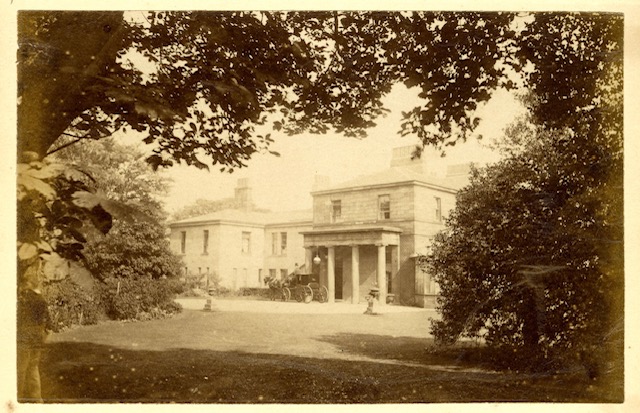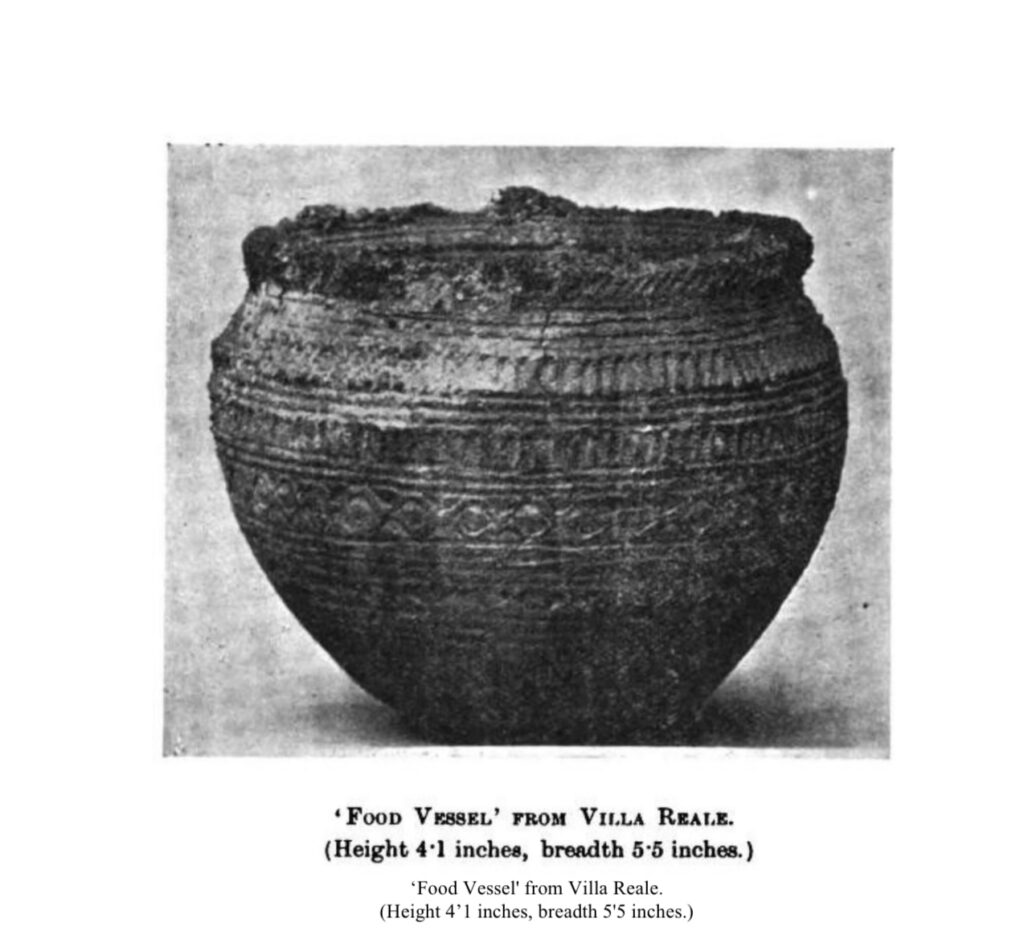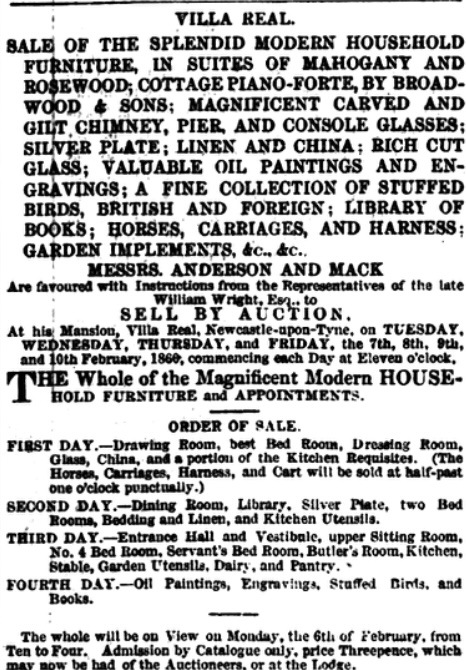A brief history of Villa Real and its connections to Jesmond Old Cemetery
By Pauline Martin.
Walking round the cemetery I noticed two grave markers that gave Villa Real as the place of death. This led me to looking at the history of the house. Why was it so called? Who else lived there and are they buried here in Jesmond Old Cemetery?
Villa Real was designed by John Dobson and built in 1817 for Captain John Dutton. It was situated along Sandyford Road and is still there today. It is recorded that it was set in 21 acres of landscaped gardens which included 2 pineries, a vinery shed, a melon ground and a fish pond with fishing house. There was also a lodge on Sandyford Road. Externally, Villa Real consists of sandstone ashlar with a roof of Welsh slate. It’s main frontage has large bow windows and Tuscan columns supporting the entrance porch. Villa Real was awarded a Grade 2 Listed status in 1987.

Villa Real in 1890
Villa Real’s first resident, born in about 1782, was John Dutton, who married Elizabeth Shadworth in 1807. Records show the baptism of Thomas Villa Real Dutton in May 1808, son of John and Elizabeth. So here we may have the reason why John called the house Villa Real, but I wonder why he gave Thomas it as his middle names? John died on the 22nd of October 1839 at Hilton Grove near Sunderland. His death was reported in the Durham County Advertiser, namely ‘John Dutton Esquire, late Captain in the Royal Anglesey Fusiliers, much and deservedly respected.’ John is buried in St Nicholas Churchyard, Boldon, alongside his youngest son Charles who died at the age of 17 from Consumption, which is also known as Phthisis and TB, tuberculosis. Several of the family died of this.
The house was bought next by Sir Thomas Burdon in the early 1820’s. Sir Thomas Burdon, Jesmond Colliery died 26th July 1826 age 68, Knight Lieutenant Colonel Commander of the Tyne Yeomanry Hussars, J.P., Alderman and twice Mayor, 1810 and 1816. I believe he is buried in Stockton on Tees.
After his death it was purchased by Russell Blackbird. Russell was born about 1771 in Newcastle, marrying Anne Robinson in 1816. They can be found on the 1841 Census return living in Villa Real – Russel was recorded as working as an Insurance Broker. In ‘An Account of Jesmond’ by Frederick Walter Dendy, it is recorded that, in 1828, Russell discovered a stone-built grave or kist-vaen while ‘trenching some ground for planting’ within the grounds of Villa Real; it measured 4 feet by 2 feet by 20 inches – and it contained the bones of a man and a food vessel. The skull was in perfect condition with a full set of teeth. When found it contained some red coloured earth which the labourers threw out!! The vessel itself can be found in the Black Gate Museum and is said to be the finest specimen of Northern pre-historic food vessels in the collection.

Russell died on 18th November 1849 and Anne died on the 22 November 1852 and are both recorded as living at Villa Real until their deaths. Both are buried in Jesmond Old Cemetery in the unconsecrated area. The grave was removed from its original position in 1971 but no headstone can be located.
William Wright became the next occupant of Villa Real. Born in 1810 in Gosforth to Gilbert Wright and his wife Margaret, William was an Iron Founder/Flint glass manufacturer. He died in 1859 and a notice in the newspaper, dated February 3rd 1860, gives notice of a sale by auction, with household furniture, glass, linen, paintings, books and horses being listed as for sale. It was not until 11th August 1865 that a further notice appeared in the Journal advertising the sale of the Villa.

In the 1861 Census we find Joseph Bamborough Wright, glass manufacturer and brother of William Wright living in the Villa. Joseph died on the 11th September 1865. The family vault can be found on the West Mound on the consecrated side of the Cemetery.
By 1871, according to the Census records, Robert Harrison can now be found living in Villa Real, having moved there in 1868 with his son and two daughters. His wife, Elizabeth, died in 1869. Robert was a Tanner with a premises on Stepney Bank. He lived in the Villa until his death in 1881 and his burial place can be found in the consecrated section of the cemetery along the Sandyford Road side. In 1881, Charles John Gibb moves into Villa Real from Westgate Road House on Westgate Road. It was then that the name changes to Sandyford Park. Charles Gibb was a Doctor and it is his name that we hear in the famous Geordie song, Blaydon Races, written by George Ridley; “Aa went to Blaydon Races, ’twas on the ninth of Joon, Eiteen hundred an’ sixty-two, on a summer’s efternoon; Aa tyuk the ‘bus frae Balmbra’s, an’ she wis heavy laden, Away we went ‘lang Collin’wood Street, that’s on the road to Blaydon. Sum went to the Dispensary an’ uthers to Doctor Gibbs, An’ sum sought out the Infirmary to mend their broken ribs.”
Dr. Gibb played an important role in combatting the towns cholera epidemic in 1853. He died on the 13th May 1916 and is buried in Elswick Cemetery.
So in the first hundred years of Villa Real’s 207 year history, to date, six families have lived there, three have been buried in the Cemetery though only two stones remain. Following the death of Dr Gibb, it was reported in the papers that “Sandyford Park, which in its time has been the home of several well-known Newcastle residents, has changed hands at a sum reported to be over £20,000. At first it was feared that the pretty grounds, which are a feature of the district, would be cut up to make room for buildings of the class that have sprung up around it within recent years, but the new owners, it is stated, do not intend to destroy the beauty. the building is likely to be used for educational purposes, and the grounds, including the rookery, will be preserved practically as the stand.”
The house was subsequently owned by the Poor Sisters of Nazareth for nearly 80 years and was known as Nazareth House – like other Nazareth Houses it housed destitute and orphaned children. In 1996 the Sisters transferred to London and for a while, the house was managed by Catholic Care North East. Today it houses Newcastle High School for girls and is known as Chapman House.
Information has been sourced from the internet, sitelines.newcastle.gov.uk,.ncl.ac.uk, newspaper articles and death certificates from GRO.